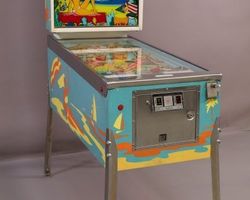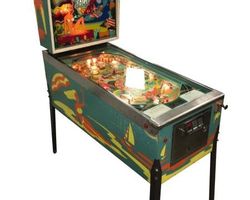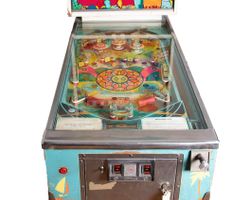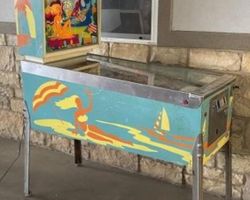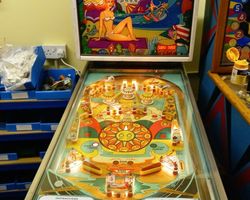Travel Time
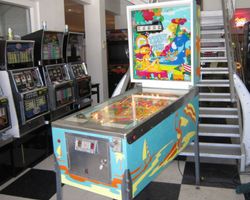
Average Prices: USD $300 to $800
Produced: September, 1972
Production Run: 3,450 units
Machine Type: Electro-mechanical
Players: 1
Design by: Norm Clark
Art by: Christian Marche
"Travel Time," a distinctive electro-mechanical (EM) pinball machine, emerged from the Williams Electronic Games, Inc. factory in February 1973. This single-player machine, with a production run of 3,450 units, distinguished itself through a core gameplay concept that departed from the prevailing ball-count standard. Rather than granting a player a fixed number of balls, "Travel Time" operates on a countdown clock, an innovative feature for its era that fundamentally reshaped player engagement.
The inspiration for "Travel Time" derived directly from Williams' own 1972 release, "Summer Time," serving as its timed counterpart. The machine’s design and concept were primarily the work of Norm Clark, who handled the overall design, mechanical engineering, and even the animation. The vibrant and evocative artwork, central to the machine's allure, was crafted by Christian Marche. Production began with a sample run of 85 units in September 1972, with the main production phase following in January 1973, shipping games through March of that year. With an estimated bill of materials at $220.10 and a distributor price of $470.00, "Travel Time" was a product of a specific economic and technological moment in pinball manufacturing. A notable technical advancement for its time, "Travel Time" incorporated a solid-state clock and DC power for its pop bumpers and flippers, allowing for faster, more energetic play actions within the otherwise EM framework.
Distinctive Features and Artistry
The defining element of the "Travel Time" pinball machine is its revolutionary time-based gameplay, prominently showcased by a physical clock integrated into the playfield. This clock creates an immediate and persistent sense of urgency, driving every shot. Beyond this central mechanic, the machine's visual presentation is a significant draw. Christian Marche’s artwork for "Travel Time" is widely appreciated for its vibrant colors and engaging theme of exotic travel. The backglass depicts tropical scenes and adventurers, while the playfield maintains this aesthetic with lush landscapes and maritime motifs, immersing the player in a vacation-like atmosphere.
Mechanically, "Travel Time" also presents some unusual design choices. It features two flippers, positioned notably wide apart, a configuration that accommodates a unique center kicker mechanism. Unlike many machines of its time, "Travel Time" completely omits slingshots, directing the flow of the ball through the pop bumpers and strategically placed targets. These design decisions contribute to a distinct play experience, where the wide flipper gap and central kicker island demand different aiming strategies and ball control techniques compared to more conventional layouts. The faster pop bumpers, powered by DC current, add an unpredictable yet exciting energy to the upper playfield.
Playfield Design and Mechanical Flow
The playfield of "Travel Time" is characterized by a symmetrical yet distinctly divided layout. The upper section is dominated by three powerful pop bumpers and a series of ten standup targets that spell out "T-R-A-V-E-L." These targets, when lit in sequence, are crucial for advancing gameplay and earning valuable time extensions. The density of the pop bumpers in this area can lead to rapid, often chaotic ball action, making precision shots a challenge.
In contrast, the lower playfield features the wide-set flippers flanking a central island, which houses a kick-out hole. This kick-out hole is a pivotal objective, as hitting it often stops the clock temporarily or awards additional time, serving as a critical strategic shot for clock management. Below the flippers, a single ball kicker is positioned centrally, designed to return the ball to play should it drain between the flippers. This feature, along with the absence of slingshots, fundamentally alters ball trajectories and encourages players to develop new nudging and flipper skills. The artwork on the playfield, with its bright blues, greens, and oranges, creates a visually appealing tropical landscape, complete with stylized waves and islands, reinforcing the machine’s travel theme. The lighting is straightforward but effective, illuminating key targets and score reels, enhancing readability without distracting from the core gameplay.
Gameplay Dynamics
The gameplay of "Travel Time" revolves entirely around its time-based system. Each game begins with a set amount of time on the clock. The primary objective is not to keep a limited number of balls in play, but rather to prolong the game by adding time to the clock. This is achieved by rolling the ball over specific "time spots" that can pause or start the clock, and crucially, by hitting designated "TIME" targets or completing the "TRAVEL" sequence of targets. Every successful hit on these targets incrementally extends the countdown, allowing for potentially lengthy and intense games.
Player progression is tied directly to clock management and target completion. Strategies often involve a delicate balance between aggressively attacking the high-scoring pop bumpers and making precise shots to the time-extending targets. The kick-out hole on the central island becomes a high-value shot for both score and time control, as successfully hitting it can temporarily halt the clock's relentless march. High scores are rewarded with replays or further time, depending on the operator's settings. The absence of ball limits (as long as time permits) means a player can theoretically keep playing for an extended period, creating a unique "just one more shot" appeal. The challenge lies not in simply keeping the ball alive, but in strategically extending the game and maximizing points within the given timeframe, making every second count.
Community Reception and Enduring Legacy
"Travel Time" holds a distinctive position within the pinball community, celebrated primarily for its innovative time-based gameplay. Enthusiasts often praise its unique approach as a refreshing departure from traditional ball-count mechanics, creating a novel tension and an addictive "just one more game" appeal. For many, the machine evokes a strong sense of nostalgia, recalling early experiences with pinball. Christian Marche's vibrant artwork consistently receives acclaim for its beauty and thematic coherence, contributing significantly to the machine's charm. Its accessibility, due to the concept of "unlimited balls" within the time limit, makes it particularly enjoyable for casual players and newcomers to the hobby. Furthermore, "Travel Time" is recognized for its early integration of solid-state components for its clock and DC power for its pop bumpers, hinting at future technological shifts in pinball while retaining its EM character.
Despite its strengths, "Travel Time" is not without its critical points. Some players find the gameplay loop to be somewhat simple, lacking the deep shot variety and strategic complexity of later machines. The dense pop bumpers in the upper playfield can lead to a degree of randomness, making it challenging to consistently hit the "TRAVEL" targets. The wide flipper spacing and the central kick-out hole, while unique, can occasionally result in unpredictable drains, which some players perceive as unfair. A significant factor in its reception is its dependence on operator settings; if the initial time or clock speed is not calibrated well, games can feel either too short and frustrating or overly long and monotonous. Regardless of these criticisms, "Travel Time" remains a unique and memorable electro-mechanical pinball machine. Its innovative time-based concept cemented its place as a machine that dared to challenge conventions, influencing the breadth of ideas explored in pinball design and solidifying its reputation as a distinctive and highly collectible piece of pinball history.
Sponsored Links
 Ebay Listings
Ebay Listings
 Auction Results
Auction Results
| Cost | Location | Date |
|---|---|---|
| USD $1,000 |  Pennsylvania, United States Pennsylvania, United States |
11 October, 2025 |
| USD $550 |  Iowa, United States Iowa, United States |
13 September, 2024 |
| USD $2,500 |  California, United States California, United States |
21 August, 2024 |
| USD $775 |  Delaware, United States Delaware, United States |
26 July, 2024 |
| USD $600 |  California, United States California, United States |
25 February, 2023 |
| USD $380 |  Texas, United States Texas, United States |
17 November, 2022 |
| USD $1,300 |  Missouri, United States Missouri, United States |
12 March, 2022 |
| GBP £756 |  Ramsgate, United Kingdom Ramsgate, United Kingdom |
05 February, 2022 |
| USD $800 |  Florida, United States Florida, United States |
27 June, 2021 |
| USD $800 |  Florida, United States Florida, United States |
25 June, 2021 |


Private Policy · Search Website · Contact Us
As an eBay Partner, we may earn a commission from qualifying purchases made through links on this site, at no additional cost to you.
All trademarks and copyrighted materials remain property of their respective owners. All other content copyright 2007 - 2025 Pinpedia.

